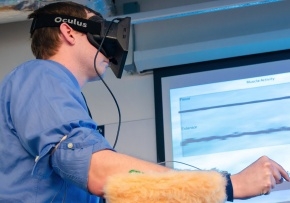Virtual Rehabilitation of Stroke Patients with Oculus Rift
Recently, six virtual reality games were released for patients with a history of debilitating strokes in order to help them recover faster. A stroke, which is often referred to a cerebrovascular accident (CVA), happens when blood flow to a part of the brain stops. When the blood flow is cut off for more than a few seconds, permanent damage to brain can occur as brain cells die due to deprivation of blood and oxygen. Most of the times, stroke causes paralysis which can either be temporary or permanent. The latest immersive gaming technology has made it possible to overcome the disability by providing the patients the virtual possibility of walking around. As the patient feels the sensation of walking, the games positively reinforce and motivate the patients. By strapping on their Oculus Rift headset, patients can transcend into another dimension where walking becomes a possibility for them.
The winning team of the TechSandbox competition organized by University of Washington’s Center for Sensorimotor Neural Engineering (CSNE) developed six immersive games to aid stroke therapy. The team was called Team vHAB and its participants included two graduate students in bio engineering, an undergraduate in bio engineering, and an undergraduate in neurobiology and behavior. Team vHAB worked with muscle activity sensors to evaluate and accelerate patient motor recovery. All the data was transferred into electronic medical records so that doctors can monitor and determine the progress of both clinical and at-home recovery. Team vHAB managed to make a great impression on the panel of industry liaison judges by developing wearable technologies, consumer devices and medical devices.
Lise Johnson, researcher and education manager at the US National Science Foundation-funded CSNE said, “The competition began as a way to engage students and faculty, and entice them to visit the center and experience, hands-on, the equipment that is available. As the course has evolved, we’ve seen the students focus on wearable technologies, consumer devices, and medical devices; our panel of industry liaison judges has been very impressed by what the students are capable of”.
The team used commercially developed video game consoles with sensors that react to actual movements of the player by recreating the actions on the screen. Stroke patients can easily play games either by themselves or in group settings. Dr. Debbie Rand, the principal investigator of the project commented, “Video games delivered in a group setting keep the participants motivated and challenged by offering variability in exercises, providing intensity and meaningful task-related movements, and providing feedback,”.
Immersive Virtual Reality Applications for Post-Stroke Motor Rehabilitation
For further information on Virtual Rehabilitation of Stroke Patients with Oculus Rift, please visit:
http://www.scienceworldreport.com/articles/13006/20140219/new-technology-enables-real-walking-around-in-virtual-reality.htm http://horizon-magazine.eu/article/virtual-reality-helps-stroke-victims-walk-again_en.html http://www.forbes.com/sites/quora/2014/06/18/how-can-the-oculus-rift-be-used-for-healthcare/
https://virtualrealitytimes.com/2014/04/02/virtual-rehabilitation-of-stroke-patients-with-oculus-rift/https://virtualrealitytimes.com/wp-content/uploads/2014/08/tyler-libey-demonstrates-vhab-a-virtual-reality-game-for-stroke-therapy-patients-involving-muscle-activity-sensors-to-measure-and-speed-up-patient-motor-recovery.jpghttps://virtualrealitytimes.com/wp-content/uploads/2014/08/tyler-libey-demonstrates-vhab-a-virtual-reality-game-for-stroke-therapy-patients-involving-muscle-activity-sensors-to-measure-and-speed-up-patient-motor-recovery-150x90.jpgHealthOculus RiftRecently, six virtual reality games were released for patients with a history of debilitating strokes in order to help them recover faster. A stroke, which is often referred to a cerebrovascular accident (CVA), happens when blood flow to a part of the brain stops. When the blood flow is...Anushay QaiserAnushay Qaiser[email protected]ContributorAnushay is a writer from Pakistan, specializing in technology and futurism. She's a big VR fan, despite living in a country without much presence in high technology or virtual reality.Virtual Reality Times - Metaverse & VR

